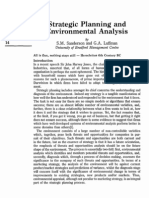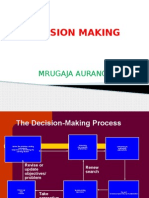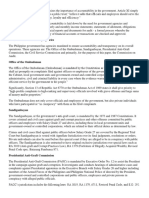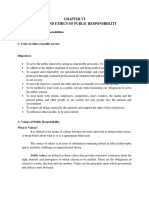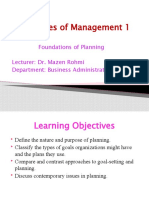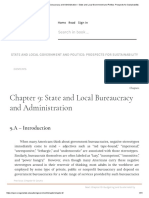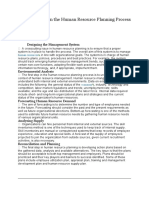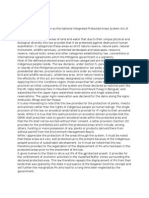Decision Making Traditional Approach
Uploaded by
SUMIT_CHAUHAN18Decision Making Traditional Approach
Uploaded by
SUMIT_CHAUHAN18To determine how adaptive management might fit into agency operations, we need to consider the ways in which agencies
make management decisions. I have defined five decision-making approaches, each of which builds on and adds to the previous approach. The first four are
traditional approaches and the fifth is adaptive management.
The first decision approach is the political/social approach, in which the main concerns are public and political response to a decision. All agency decisions involve political and social considerations to some degree. The political/social approach sometimes dictates a specific course of action to appease a powerful interest or to keep options open for the future. However, a decision to do nothing or to delay action until more data are available is often a political/social decision. Second is the conventional-wisdom approach, in which managers use an historical method or rule-of-thumb that has been applied to similar situations in the past. In this approach, managers typically rely on historical knowledge of the situation and the resource involved, and assume that the response to management will be similar to that experienced previously. Many of an agency's recurring decisions, such as how many fish to stock, how many board feet to cut, or what level of a pollutant to allow, are probably made using this approach. Third is the best-current-data approach, which uses current data collected through new or existing sampling programs. Managers analyze these data using the latest techniques, assess their management options, and then choose the one best option to implement. This approach is appealing because it uses the best available knowledge and techniques. Examples of this approach include many habitat enhancement projects and management for various forms of optimal sustained yield. The fourth is the monitor-and-modify approach. With this approach, a policy decision is typically made using the conventional wisdom or best-current-data methods, and then the policy is implemented along with a monitoring plan. Monitoring data are used to evaluate and periodically modify the policy relative to a specific goal, such as total allowable harvest, production of habitat units, or concentration of some pollutant. The purpose of periodic modifications is to "hone" the management policy and maintain the system in an optimal state. Most management that involves annual resource assessments and policy updating is conducted using this approach, including management of many marine fish stocks. Fifth is the adaptive management approach. Typically, adaptive management begins by bringing together interested parties (stakeholders) in workshops to discuss the management problem and the available data, and then to develop computer models that express participants' collective understanding of how the system operates. The models are used to assess the significance of data gaps and uncertainties and to predict the effects of alternative management actions. The stakeholders develop a management plan that will help to meet management goals and will also generate new information to reduce critical data gaps and uncertainties. The management plan is then implemented along with a monitoring plan. As monitoring proceeds, new data are analyzed and management plans are revised as we improve our understanding of how the system works.
These five decision-making approaches constitute a progression of increasing complexity. Each successive approach adds features that focus more agency resources on the problem; thus, the costs of implementation and evaluation increase as one moves up the list. For example, implementing the conventional-wisdom approach is quick and cheap, and evaluation is usually conducted informally using personal observations and feedback from field personnel or resource users. Adaptive management, in contrast, requires considerable time and money to organize workshops for stakeholders, develop models and policy assessments, and monitor the effects of management. However, if more complex decision-making approaches lead to more effective management, they may be cheaper in the long run. Most natural resource managers have responsibilities that cover an extensive array of resources and require many decisions, often made under limited budgets and short time frames. Efficiency in decision making is always desirable, which leads to an Occam's razor approach: never use a more complex decision process than is necessary. Thus, I would argue that managers use the simplest approach that seems appropriate for the problem, and move to more complicated approaches only if the simpler approach fails.
You might also like
- (Practical Resources for the Mental Health Professional) Sharon L. Johnson-Therapist's Guide to Clinical Intervention, Second Edition_ The 1-2-3's of Treatment Planning (Practical Resources for the Me(1).pdf100% (9)(Practical Resources for the Mental Health Professional) Sharon L. Johnson-Therapist's Guide to Clinical Intervention, Second Edition_ The 1-2-3's of Treatment Planning (Practical Resources for the Me(1).pdf594 pages
- Yelp For Health: Using The Wisdom of Crowds To Find High82% (108)Yelp For Health: Using The Wisdom of Crowds To Find High20 pages
- Book Summary The Practice of Adaptive Leadership by Heifetz Grashow Linsky100% (10)Book Summary The Practice of Adaptive Leadership by Heifetz Grashow Linsky23 pages
- Education Management Information System (EMIS) : Integrated Data and Information Systems and Their Implications in Educational ManagementNo ratings yetEducation Management Information System (EMIS) : Integrated Data and Information Systems and Their Implications in Educational Management26 pages
- 17 Tips To Improve Your Nursing Documentation100% (3)17 Tips To Improve Your Nursing Documentation26 pages
- 4 Types of Approach To Decision 3.4 Dipti.kNo ratings yet4 Types of Approach To Decision 3.4 Dipti.k5 pages
- Planning and Decision Making in Public Management PDFNo ratings yetPlanning and Decision Making in Public Management PDF34 pages
- Roles and Responsibilities of Local Government Leaders: Legislative BodiesNo ratings yetRoles and Responsibilities of Local Government Leaders: Legislative Bodies6 pages
- ProductiProductivity Concepts and Measures1No ratings yetProductiProductivity Concepts and Measures18 pages
- Project Selection (CH 4) : Dr. James J. Jiang University of Central FloridaNo ratings yetProject Selection (CH 4) : Dr. James J. Jiang University of Central Florida21 pages
- Strategic Planning and Environmental AnalysisNo ratings yetStrategic Planning and Environmental Analysis14 pages
- TOPIC 6 Introduction To Planning and Decision Making For Law Enforcement (5 Lectures)100% (1)TOPIC 6 Introduction To Planning and Decision Making For Law Enforcement (5 Lectures)6 pages
- Download ebooks file Crisis and Emergency Management Theory and Practice Second Edition Louise K Comfort Affiliation: University Of Pittsburgh all chapters100% (15)Download ebooks file Crisis and Emergency Management Theory and Practice Second Edition Louise K Comfort Affiliation: University Of Pittsburgh all chapters85 pages
- A Review of The Validity of Criminal ProfilingNo ratings yetA Review of The Validity of Criminal Profiling7 pages
- Management (1903) and The Principles of Scientific Management (1911)100% (1)Management (1903) and The Principles of Scientific Management (1911)18 pages
- The Role of Communications in Negotiations100% (1)The Role of Communications in Negotiations30 pages
- Principles of Management 1: Foundations of Planning Lecturer: Dr. Mazen Rohmi Department: Business AdministrationNo ratings yetPrinciples of Management 1: Foundations of Planning Lecturer: Dr. Mazen Rohmi Department: Business Administration30 pages
- (Ebook - English) Covey, S R - The 7 Habits of Highly Effective PeopleNo ratings yet(Ebook - English) Covey, S R - The 7 Habits of Highly Effective People4 pages
- Chapter 9 - State and Local Bureaucracy and Administration - State and Local Government and Politics - Prospects For SustainabilityNo ratings yetChapter 9 - State and Local Bureaucracy and Administration - State and Local Government and Politics - Prospects For Sustainability31 pages
- Accountability and Transparency in Governance100% (1)Accountability and Transparency in Governance4 pages
- Key Concepts and Principles in Public Administration 2verNo ratings yetKey Concepts and Principles in Public Administration 2ver19 pages
- Class 10 Public Servcice Corruption in BangladeshNo ratings yetClass 10 Public Servcice Corruption in Bangladesh21 pages
- Education Management Information System (EMIS)No ratings yetEducation Management Information System (EMIS)15 pages
- Clinical Governance: The Challenges of Implementation in Iran100% (1)Clinical Governance: The Challenges of Implementation in Iran10 pages
- Ethical Issues in Organisational CultureNo ratings yetEthical Issues in Organisational Culture5 pages
- Importance of Communication Adrian MazilNo ratings yetImportance of Communication Adrian Mazil9 pages
- Steps in The Human Resource Planning ProcessNo ratings yetSteps in The Human Resource Planning Process7 pages
- Transparency of Transactions and Access To Information: Republic Act No. 6713No ratings yetTransparency of Transactions and Access To Information: Republic Act No. 671316 pages
- Scope of Strategic Management, Business Policy, Strategic Decision Making ProcessNo ratings yetScope of Strategic Management, Business Policy, Strategic Decision Making Process3 pages
- Advanced Excel Charts Big Data & Analytics100% (1)Advanced Excel Charts Big Data & Analytics102 pages
- Books For ZNO Your Personality and You Workbook Yael H Dubin MD PDF100% (5)Books For ZNO Your Personality and You Workbook Yael H Dubin MD PDF167 pages
- 10 Basic Tips To Building Your First LS Engine100% (2)10 Basic Tips To Building Your First LS Engine17 pages
- 07 GMGT 2070 - Bad Apples & Good Citizens at WorkNo ratings yet07 GMGT 2070 - Bad Apples & Good Citizens at Work27 pages
- Kuzio Disinformation Soviet Origins of Contemporary Russian UkrainophobiaNo ratings yetKuzio Disinformation Soviet Origins of Contemporary Russian Ukrainophobia39 pages
- PDF The Journalist's Toolbox: A Guide To Digital Reporting and AI 1st Edition Mike Reilley Download100% (3)PDF The Journalist's Toolbox: A Guide To Digital Reporting and AI 1st Edition Mike Reilley Download79 pages
- Gwen Stefani Yahin BS Psychology 2B: 8 Theories of GlobalizationNo ratings yetGwen Stefani Yahin BS Psychology 2B: 8 Theories of Globalization2 pages
- Translation Wheel Block - RS Series, The Solution For Harsh Applications, DeMAG CRANES & COMPONENTS GMBH, GermanyNo ratings yetTranslation Wheel Block - RS Series, The Solution For Harsh Applications, DeMAG CRANES & COMPONENTS GMBH, Germany1 page
- Paytm Wallet TXN HistoryJan2020 9369204281 PDFNo ratings yetPaytm Wallet TXN HistoryJan2020 9369204281 PDF2 pages
- Prevention of Illegal Working and Right To Work in The UK PolicyNo ratings yetPrevention of Illegal Working and Right To Work in The UK Policy7 pages
- Organizational Behavior: Common Biases and Errors in Decision MakingNo ratings yetOrganizational Behavior: Common Biases and Errors in Decision Making13 pages




























